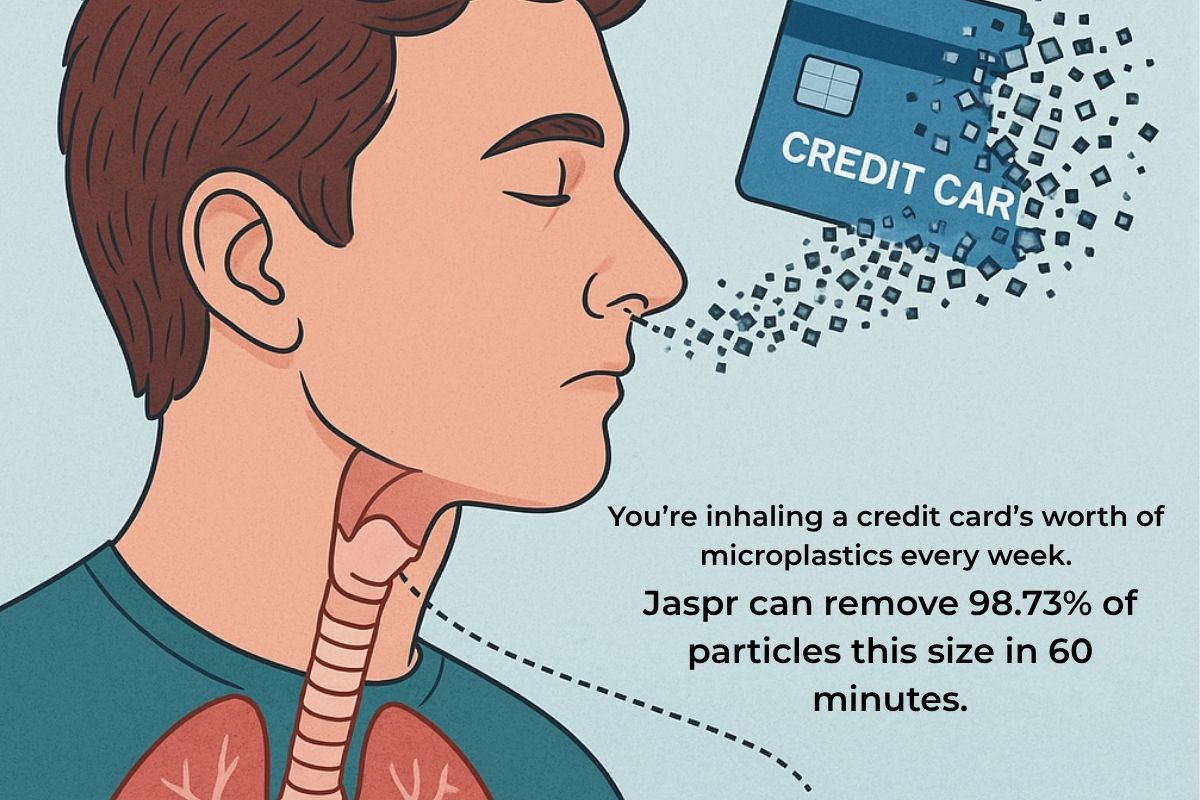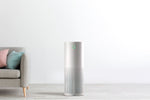🧫 You’re Breathing Microplastics — Here’s What You Can Do About It

Humans breathe in the equivalent of a credit card’s worth of microplastics every single week.
And that’s on top of what we ingest in food and water.
What is a microplastic?
Microplastics are plastic particles smaller than 5 millimeters — and often much smaller, down to nanometers in size. They’re created when larger plastic products break down over time through wear, UV exposure, friction, and environmental degradation.
They’re now ubiquitous: found in oceans, drinking water, food, soil, and increasingly — the air we breathe.
A 2024 systematic review published in the Journal of Exposure Science & Environmental Epidemiology explains:
“Plastics break down into smaller pieces, a process called fragmentation… microplastics have been found in water and soil, and recent research is exposing the vast amount of them in ambient and indoor air.”
— Eberhard et al., 2024
🌫️ Where Do Airborne Microplastics Come From?
-
Clothing and textiles (like polyester, nylon, fleece) shed microfibers during the wear, washing and dryer
-
Car tires degrade as we drive, spewing microplastic dust into the air.
-
Packaging, plastic flooring, and even some furniture release particles over time.
-
HVAC systems can circulate these particles indoors, and urban areas can stir them up outdoors.
In fact, indoor spaces can be worse:
“Indoor average exposures are higher for all age groups compared with outdoor doses.”
— Eberhard et al., 2024
These ultra-fine particles — often smaller than 1 micron — are easy to inhale and nearly impossible for the body to filter out. Some enter the lungs. Others may pass into the bloodstream.
These particles — some smaller than a single micron — are easily inhaled. And because plastic is not biodegradable, some particles may remain in the body or even enter the bloodstream.
Researchers have found microplastics in human lung tissue, and early studies suggest that inhalation could contribute to inflammation, immune disruption, and hormone imbalance.
“Microplastics can be transported throughout the body depending on size and may end up in various organs.”
— Eberhard et al., 2024
________________________________________________________
Proof That They're in the Air — and We're Inhaling Them
The 2024 study by Eberhard et al. is the first known systematic review quantifying airborne microplastic exposure across different age groups and indoor/outdoor environments.
It concluded that:
-
Infants have the highest exposure levels
-
Indoor exposure far exceeds outdoor exposure
-
Even remote areas (like mountaintops and farmland) show traces of airborne microplastics, suggesting long-distance atmospheric transport
-
Microplastics have been found on rooftops, in schools, hospitals, and homes
But while studies like these confirm the problem, there’s currently no standardized test to determine if an air purifier can actually remove microplastic particles.
🧪 What Can You Do About It?
Here’s the challenge: Most home air purifiers are designed to trap dust, pollen, and smoke — all of which are larger than many airborne microplastics.
If you want protection, you need something capable of filtering ultrafine particles, all the way down to 0.01 microns.
We recently decided to conduct a new lab test to quantify just how effective Jaspr is at scrubbing the air of microplastic-sized particles.
🔬 Why a Latex Bead Test?
There’s no standardized test yet for airborne microplastics — the science is still catching up. So, we partnered with an independent lab to run the closest simulation possible: a latex bead decay test, using particles that match the exact size range of airborne microplastics, from 0.016 to 10 microns.
Latex beads are commonly used in scientific studies because they behave similarly to ultrafine pollutants, allowing researchers to track their movement and removal with precision.
📈 The Results: 98.73% of Particles Removed in 60 Minutes
Here’s what the Jaspr Air Scrubber achieved in the test chamber:
-
98.73% of Particles Removed in 60 Minutes
-
CADR (Clean Air Delivery Rate): 276.4 CFM for particles as small as 0.016 microns
That’s ultrafine filtration well beyond what most consumer air purifiers are designed to handle.
In fact, most don’t even test below 0.3 microns — meaning they can’t guarantee removal of airborne plastic particles.
Jaspr was designed differently — to protect against what you can’t see.

👉 [Click here to read the full lab study report]
🛡️ Why This Matters
Most air products focus on what we can see and measure — like dust and pollen.
But the real danger is what we can’t see: smoke, smog, chemical off-gassing, and now, plastic particles hanging in the air of our homes.
This study confirms that the Jaspr Air Scrubber removes those particles with power and precision — including the most concerning class of invisible indoor pollutants: microplastics.
✨ Final Thoughts: Breathe Cleaner, Plastic-Free Air
We can’t control every source of plastic in the world.
But we can take back the air we breathe inside our own homes.
Whether you’re concerned about wildfire smoke, urban smog, or the plastic dust you didn’t even know was in your living room, the Jaspr Air Scrubber is equipped — and tested — to take care of it.
Because when you don't filter your air, your lungs are the filter.
Back to Blog



